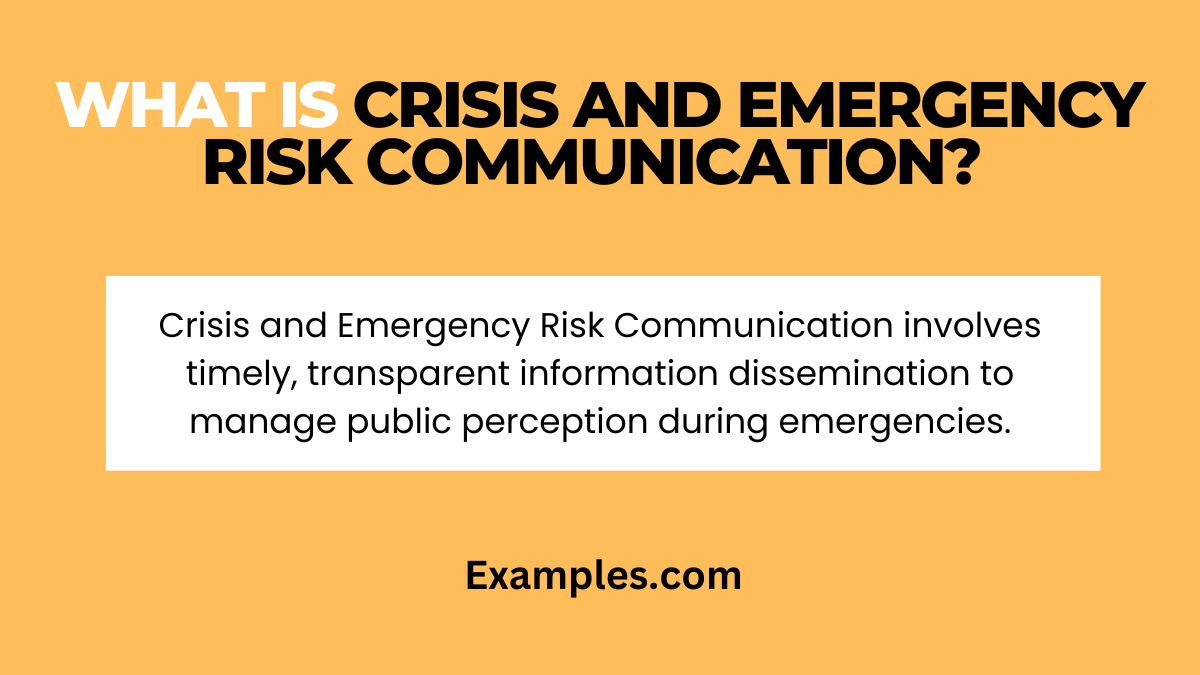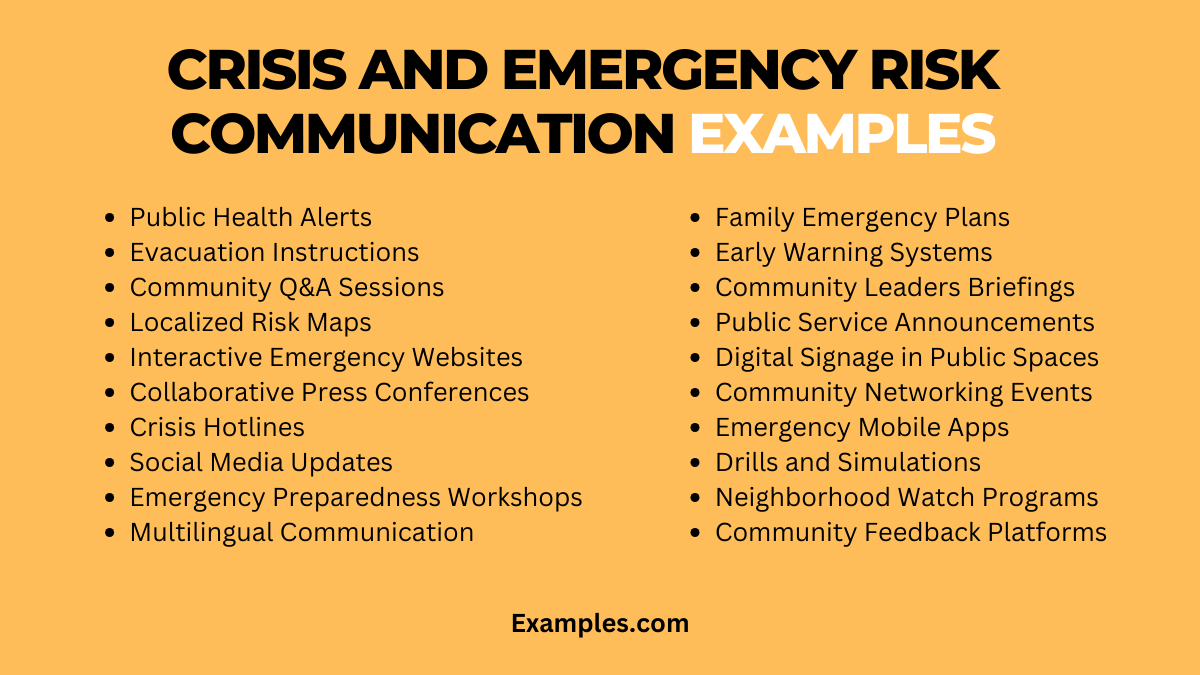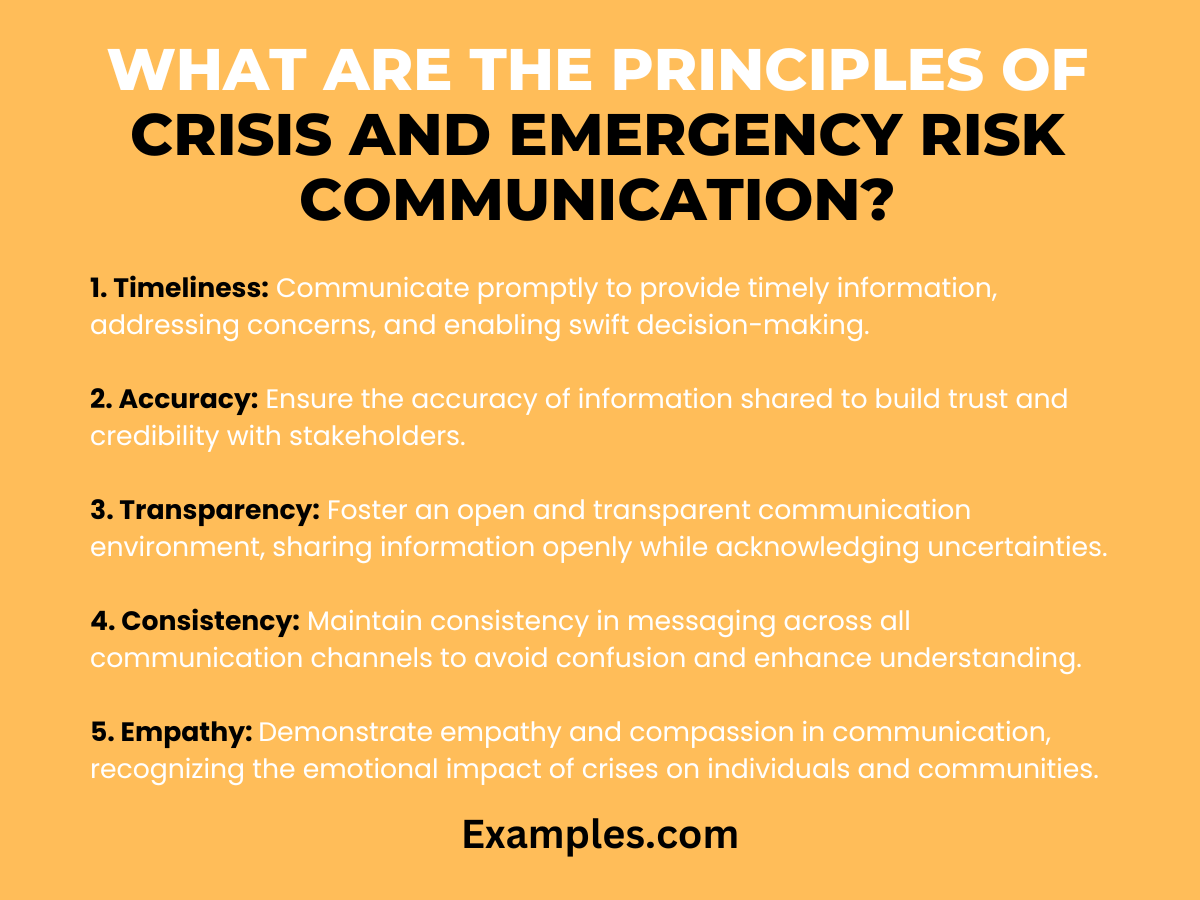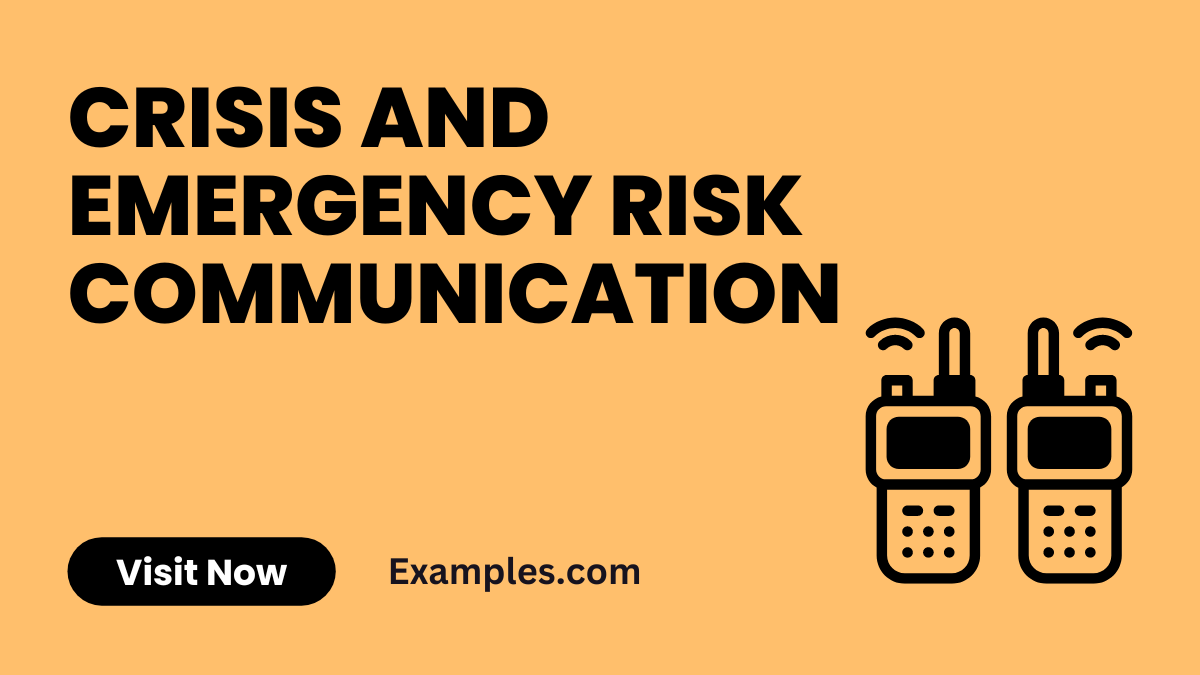19+ Crisis and Emergency Risk Communication (CERC) Examples
Embark on a comprehensive exploration of Crisis and Emergency Risk Communication, where strategic communication meets crisis resilience. This guide unveils the principles, tips, and communication examples essential for navigating uncertainties effectively. From real-world scenarios to expert strategies, immerse yourself in this complete resource that empowers you to communicate with precision and compassion during crises, ensuring a resilient response to emergencies. Your go-to guide for mastering Crisis and Emergency Risk Communication.
What is Crisis and Emergency Risk Communication?

Crisis and Emergency Risk Communication (CERC) is a strategic approach that emphasizes clear, timely, and accurate communication during emergencies. It aims to empower individuals, communities, and organizations to make informed decisions, manage risks, and respond effectively to crises. CERC focuses on fostering understanding, building trust, and providing actionable information, ensuring that communication plays a pivotal role in enhancing overall resilience and mitigating the impact of crises and emergencies.
20 Crisis and Emergency Risk Communication Examples

Explore 20 compelling Crisis and Emergency Risk Communication (CERC) examples demonstrating effective communication in challenging scenarios. This curated collection showcases how clear, timely, and accurate communication can mitigate risks and empower communities during emergencies.
- Public Health Alerts: Swiftly issue public health alerts to inform communities about emerging risks and preventive measures, fostering a sense of urgency and preparedness.
- Evacuation Instructions: Clearly communicate evacuation instructions, providing step-by-step guidance for a safe and organized evacuation process.
- Community Q&A Sessions: Host virtual or in-person Q&A sessions to address community concerns, ensuring transparent communication and addressing uncertainties.
- Localized Risk Maps: Develop risk maps detailing localized threats, facilitating targeted communication to areas at higher risk during emergencies.
- Interactive Emergency Websites: Launch interactive websites offering real-time updates, resources, and actionable information, empowering individuals to stay informed and take appropriate actions.
- Collaborative Press Conferences: Conduct collaborative press conferences involving multiple agencies to present a united front and disseminate consistent information to the public.
- Crisis Hotlines: Establish crisis hotlines for direct communication with the community, offering a reliable channel for information exchange and assistance during emergencies.
- Social Media Updates: Leverage social media platforms for regular updates, engaging visuals, and interactive content to reach a wider audience and promote community involvement.
- Emergency Preparedness Workshops: Conduct workshops on emergency preparedness, equipping individuals with the knowledge to handle crises and disseminate information effectively.
- Multilingual Communication: Ensure communication is available in multiple languages, promoting inclusivity and reaching diverse communities during emergencies.
- Family Emergency Plans: Encourage families to create personalized emergency plans, fostering individual responsibility and preparedness for potential risks.
- Early Warning Systems: Implement early warning systems to notify communities about impending risks, enabling proactive measures and reducing the impact of emergencies.
- Community Leaders Briefings: Provide community leaders with briefings and resources, empowering them to disseminate accurate information and support community members during crises.
- Public Service Announcements (PSAs): Develop impactful PSAs for radio, television, and online platforms, delivering concise messages to the public for immediate action.
- Digital Signage in Public Spaces: Utilize digital signage in public spaces to display real-time emergency information, ensuring widespread awareness and quick response.
- Community Networking Events: Organize community networking events to strengthen connections, facilitating efficient communication channels and support structures during crises.
- Emergency Mobile Apps: Launch user-friendly mobile apps offering real-time updates, emergency contacts, and guidance, enhancing accessibility to critical information.
- Drills and Simulations: Conduct regular crisis drills and simulations, preparing communities for emergency scenarios and reinforcing effective communication protocols.
- Neighborhood Watch Programs: Establish neighborhood watch programs for mutual support and communication, fostering a sense of community responsibility during crises.
- Community Feedback Platforms: Create platforms for community feedback, enabling two-way communication and addressing specific concerns, ultimately enhancing the effectiveness of crisis responses.
Crisis and Emergency Risk Communication Examples for Business
Discover how effective Crisis and Emergency Risk Communication (CERC) is vital in the corporate realm. Explore tailored examples demonstrating how businesses navigate crises, ensuring transparent communication, and maintaining stakeholder trust during emergencies.
- Leadership Updates in Crisis: Provide regular updates from leadership, assuring stakeholders of proactive crisis management and maintaining transparency in challenging times.
- Supply Chain Disruptions: Communicate supply chain disruptions promptly, outlining alternative plans and mitigating potential business impacts with clear and decisive communication.
- Employee Wellness Programs: Implement employee wellness programs and communicate mental health support during crises, demonstrating organizational care and fostering a resilient workforce.
- Financial Stability Messages: Address financial concerns with clear messages on stability, reassuring investors, customers, and partners about the organization’s financial resilience and long-term strategy.
- Customer Outreach Campaigns: Launch customer outreach campaigns during crises, offering support, resources, and transparent information to maintain customer loyalty and trust.
Crisis and Emergency Risk Communication Examples for Students
Explore Crisis and Emergency Risk Communication (CERC) tailored for students, focusing on educational settings. Uncover examples illustrating effective communication strategies that ensure student safety, well-being, and informed decision-making during emergencies.
- Campus Emergency Text Alerts: Implement campus-wide emergency text alerts, ensuring real-time communication with students about potential risks and safety instructions.
- Online Learning Support Hub: Establish an online learning support hub during crises, providing students with resources, updates, and a central platform for communication.
- Peer-to-Peer Safety Initiatives: Encourage peer-to-peer safety initiatives, fostering a sense of community responsibility and enabling students to communicate and support each other during emergencies.
- Virtual Student Town Halls: Conduct virtual town halls for students, offering a platform for open communication, addressing concerns, and providing transparent updates during emergencies.
- Interactive Crisis Webinars: Organize interactive crisis webinars, engaging students in discussions about emergency preparedness, risk mitigation, and effective communication within the academic community.
What are the Principles of Crisis and Emergency Risk Communication?

Crisis and Emergency Risk Communication (CERC) is guided by key principles that form the foundation for effective communication during challenging situations. Understanding these principles is essential for crafting impactful messages that ensure public safety and mitigate risks.
- Timeliness: Communicate promptly to provide timely information, addressing concerns, and enabling swift decision-making.
- Accuracy: Ensure the accuracy of information shared to build trust and credibility with stakeholders.
- Transparency: Foster an open and transparent communication environment, sharing information openly while acknowledging uncertainties.
- Consistency: Maintain consistency in messaging across all communication channels to avoid confusion and enhance understanding.
- Empathy: Demonstrate empathy and compassion in communication, recognizing the emotional impact of crises on individuals and communities.
- Actionable Information: Provide clear, actionable guidance to empower individuals to make informed decisions and take necessary steps.
- Audience Segmentation: Tailor messages to specific audience segments, recognizing diverse needs and concerns.
- Involvement of Stakeholders: Engage key stakeholders in the communication process, ensuring a collaborative and unified response.
What are the Stages of Crisis and Emergency Risk Communication?
Navigating crises involves a strategic approach, and understanding the stages of Crisis and Emergency Risk Communication (CERC) is crucial for an effective response.
- Risk Assessment and Planning: Evaluate potential crises, plan communication strategies, and identify key stakeholders.
- Coordination and Collaboration: Establish communication networks, collaborate with relevant entities, and coordinate crisis response efforts.
- Message Development: Craft clear, consistent, and actionable messages tailored to the nature of the crisis and the target audience.
- Message Dissemination: Implement communication channels to deliver messages effectively, reaching the intended recipients promptly.
- Monitoring and Evaluation: Continuously assess the impact of communication efforts, adjust strategies as needed, and gather feedback for improvement.
What is the Purpose of Crisis and Emergency Risk Communication?
The overarching purpose of Crisis and Emergency Risk Communication (CERC) is to safeguard public safety and well-being during crises. This strategic communication approach serves several key objectives.
- Risk Mitigation:
- Providing information to mitigate immediate risks and dangers.
- Guiding individuals and communities on preventive measures.
- Trust Building:
- Establishing and maintaining trust with stakeholders through transparent and honest communication.
- Building confidence in crisis management strategies.
- Empowerment:
- Empowering individuals with actionable information for informed decision-making.
- Facilitating a sense of control and resilience among the public.
- Community Resilience:
- Enhancing community resilience by fostering a culture of preparedness and cooperation.
- Promoting adaptive behaviors during and after crises.
- Information Management:
- Managing information flow effectively to avoid misinformation.
- Ensuring accurate and timely dissemination of critical information.
- Reputation Management:
- Protecting and preserving the reputation of organizations and authorities involved.
- Responding proactively to address concerns and misconceptions.
In conclusion, Crisis and Emergency Risk Communication (CERC) is a vital framework ensuring effective communication during challenging times. By adhering to principles, navigating stages, and understanding its purpose, CERC becomes a powerful tool for safeguarding communities. Through the diverse examples provided, this complete guide empowers communicators to navigate crises, build resilience, and foster trust, emphasizing the crucial role of clear and strategic communication in times of emergency.



